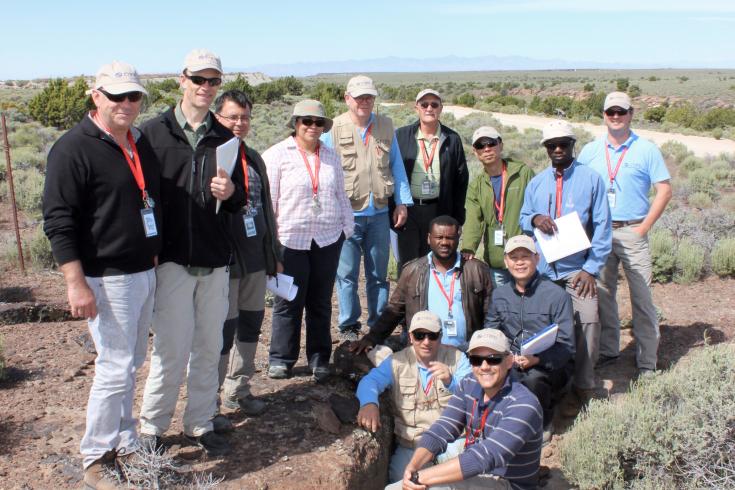First OSI activity at the former Nevada Test Site
From 16 to 20 May 2016, the United States National Nuclear Security Administration hosted the on-site inspection (OSI) Nevada Familiarization Activity at the Nevada National Security Site (NNSS), the former U.S. nuclear test site. It was the first OSI activity to ever be carried out at NNSS, and only the second time a former nuclear test site was used for an OSI activity, the first being the Integrated Field Exercise in 2008 (IFE08) at Semipalatinsk in Kazakhstan.
An OSI can be requested by any State Party and is the final measure in verifying compliance with the Comprehensive Nuclear-Test-Ban Treaty (CTBT), once it has entered into force. During an OSI, a team of up to 40 international experts searches for indications and findings of a nuclear explosion.
Around 50 experts from more than 30 countries representing the six Treaty-defined world regions took part in the familiarization activity in Nevada. The focus was on providing insights on which “observables” – visible or detectible signs – could be expected after an underground nuclear explosion. With 928 nuclear explosions between 1951 and 1992, more nuclear tests were conducted at the Nevada Test Site than anywhere else (interactive map).
The U.S. contributions to the OSI effort have been substantial, not only by recently hosting us in Nevada, but throughout the history of our organization. U.S. experience with nuclear explosive testing allows U.S. experts to pass along their knowledge to the inspectors who will be ready to find evidence of a nuclear explosion once the Treaty enters into force. We need to make sure these international experts are as well qualified and trained as possible, and coming to Nevada to see the effects from real nuclear explosions in a variety of geologies has been a tremendous experience for our surrogate inspectors. We thank the United States for its many contributions to advance the readiness of the OSI system.
The week began with a tour of the National Atomic Testing Museum where participants were provided with an overview of legacy nuclear explosive testing activities. Activities at NNSS gave participants the opportunity to familiarize themselves with different phenomena produced by nuclear explosions, such as evidence of faulting and fracturing in the ground. At Pahute Mesa, one of the site’s former major nuclear explosive test areas where tests were conducted in hard rock and at greater depths that masked surface effects, participants were challenged to identify observables.
Participants test personal dosimeters during the health and safety briefing before departing for NNSS.

Visit to the Pahute Mesa area at the former Nevada Test Site where nuclear explosive tests were conducted in welded tuff. Here participants observe how geology can affect what features are present at a given site.
The Nevada Familiarization Activity was an unprecedented opportunity for OSI surrogate inspectors to learn from, examine and analyse the remnants of legacy nuclear explosive testing first hand. This experience can be considered as one of the most significant in the history of OSI surrogate inspector activities as there is no substitute for the education the surrogate inspectors received at the Nevada National Security Site from a team of dedicated U.S. national experts.
Participants also viewed nuclear explosive testing infrastructure such as large hole drilling equipment, diagnostics cables, and equipment used to lower the device and instrumentation into the testing shaft. Participants further visited the site of the Source Physics Experiment where research and development is currently being conducted to improve the monitoring of underground nuclear explosions in granite rock areas.
Participating in the Nevada Familiarization Activity has opened my eyes to the size and scale of experiments and nuclear explosive tests at the NNSS. This important knowledge will help me to have a deeper insight when planning geophysical surveys during OSI training activities and exercises as well as during future potential inspections after entry into force of the Treaty. Understanding the geological conditions of the site was an important aspect of understanding UNE signatures as the surrounding geology can greatly control or influence the manifestation of observables after a test. This is an experience that every surrogate inspector and trainee should have.
United States and the CTBT
The United States was the very first country to sign the CTBT on 24 September 1996, the day it opened for signature. It is one of eight countries that still must ratify the Treaty so that it can enter into force.
The United States hosts 37 International Monitoring System facilities (map), more than any other country. In addition to being the largest single regular contributor to the CTBTO’s budget, the United States also makes significant voluntary contributions to the organization’s work. See country profile for more information.
For NNSA, hosting the Familiarization Activity gave us the opportunity to explore how working on a former test site can enhance the training and capabilities of future CTBTO inspectors. The visit took surrogate inspectors out of the classroom and into an environment where they were experiencing the full range of challenges that they might experience in a real OSI. We were also able to demonstrate how we have transformed the Nevada National Security Site from a test site to a test bed for a broad range of activities supporting out nonproliferation and arms control missions.